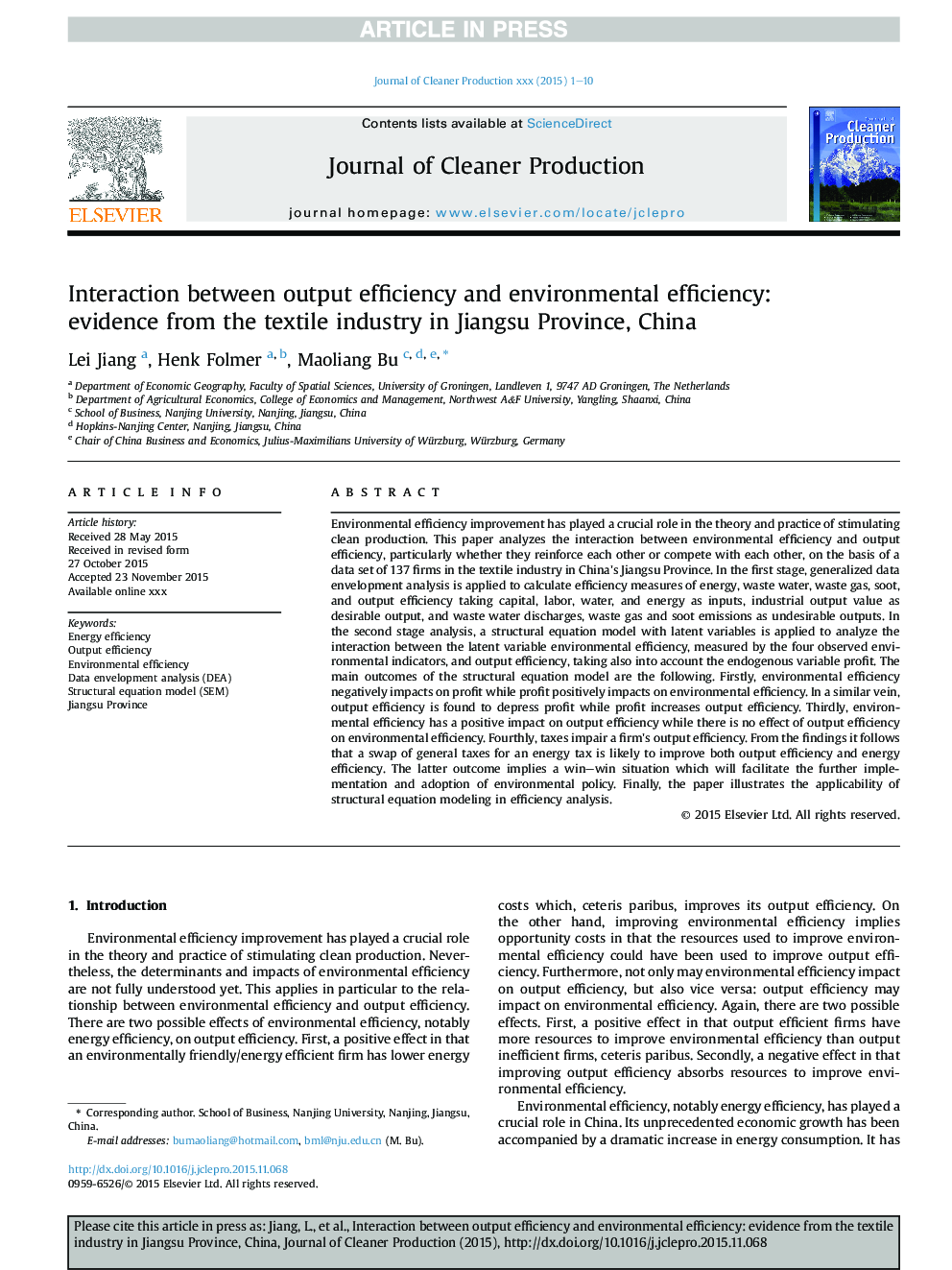| کد مقاله | کد نشریه | سال انتشار | مقاله انگلیسی | نسخه تمام متن |
|---|---|---|---|---|
| 8102823 | 1522136 | 2016 | 10 صفحه PDF | دانلود رایگان |
عنوان انگلیسی مقاله ISI
Interaction between output efficiency and environmental efficiency: evidence from the textile industry in Jiangsu Province, China
ترجمه فارسی عنوان
تعامل بین بهره وری خروجی و بهره وری محیط: شواهدی از صنعت نساجی در استان جیانگسو، چین
دانلود مقاله + سفارش ترجمه
دانلود مقاله ISI انگلیسی
رایگان برای ایرانیان
کلمات کلیدی
ترجمه چکیده
بهبود بهره وری محیطی در تئوری و تمرین تحریک تولید تمیز نقش مهمی ایفا کرده است. در این مقاله تعامل بین بهره وری محیط و بهره وری خروجی، به ویژه اینکه آیا آنها تقویت یکدیگر و یا رقابت با یکدیگر، بر اساس مجموعه داده های 137 شرکت در صنعت نساجی در استان جیانگ سو چین چیره می شود. در مرحله اول، تجزیه و تحلیل پوششی داده ها به طور کلی برای محاسبه اندازه گیری کارایی انرژی، فاضلاب، گاز پسماند، دوده و بازده خروجی از سرمایه، نیروی کار، آب و انرژی به عنوان ورودی، ارزش تولید صنعتی به عنوان خروجی مطلوب و ضایعات تخلیه آب، گازهای خروجی گاز و گازهای گلخانه ای به عنوان خروجی های نامطلوب. در تجزیه و تحلیل مرحله دوم، یک مدل معادلات ساختاری با متغیرهای پنهان به منظور تجزیه و تحلیل تعامل بین کارایی محیط زیست متغیر پنهان، اندازه گیری شده توسط چهار شاخص های محیطی مشاهده شده و بهره وری خروجی، همچنین با توجه به سود متغیر درونی متغیر، مورد استفاده قرار می گیرد. نتایج اصلی مدل معادلات ساختاری زیر است. اولا، بهره وری محیطی منفی بر سود اثر می گذارد در حالیکه سود مثبت بر راندمان محیط زیست تاثیر می گذارد. در همین حالت، بهره وری خروجی کاهش سود را افزایش می دهد در حالی که سود بازدهی تولید را افزایش می دهد. سوم اینکه، بهره وری محیطی تاثیر مثبتی بر راندمان خروجی دارد، در حالی که اثر بازده خروجی بر کارایی محیطی اثر ندارد. چهارم: مالیات یک راندمان خروجی شرکت را کاهش می دهد. از یافته های این نتیجه می رسد که مبادله مالیات کلی برای یک مالیات انرژی، احتمالا به بهبود بهره وری خروجی و بهره وری انرژی کمک خواهد کرد. نتیجه نهایی به این نتیجه می رسد که شرایط به نفع برنده است که پیاده سازی و پذیرش بیشتر سیاست های زیست محیطی را تسهیل می کند. در نهایت، مقاله کاربرد کاربرد مدل سازی معادلات ساختاری در تحلیل کارایی را نشان می دهد.
موضوعات مرتبط
مهندسی و علوم پایه
مهندسی انرژی
انرژی های تجدید پذیر، توسعه پایدار و محیط زیست
چکیده انگلیسی
Environmental efficiency improvement has played a crucial role in the theory and practice of stimulating clean production. This paper analyzes the interaction between environmental efficiency and output efficiency, particularly whether they reinforce each other or compete with each other, on the basis of a data set of 137 firms in the textile industry in China's Jiangsu Province. In the first stage, generalized data envelopment analysis is applied to calculate efficiency measures of energy, waste water, waste gas, soot, and output efficiency taking capital, labor, water, and energy as inputs, industrial output value as desirable output, and waste water discharges, waste gas and soot emissions as undesirable outputs. In the second stage analysis, a structural equation model with latent variables is applied to analyze the interaction between the latent variable environmental efficiency, measured by the four observed environmental indicators, and output efficiency, taking also into account the endogenous variable profit. The main outcomes of the structural equation model are the following. Firstly, environmental efficiency negatively impacts on profit while profit positively impacts on environmental efficiency. In a similar vein, output efficiency is found to depress profit while profit increases output efficiency. Thirdly, environmental efficiency has a positive impact on output efficiency while there is no effect of output efficiency on environmental efficiency. Fourthly, taxes impair a firm's output efficiency. From the findings it follows that a swap of general taxes for an energy tax is likely to improve both output efficiency and energy efficiency. The latter outcome implies a win-win situation which will facilitate the further implementation and adoption of environmental policy. Finally, the paper illustrates the applicability of structural equation modeling in efficiency analysis.
ناشر
Database: Elsevier - ScienceDirect (ساینس دایرکت)
Journal: Journal of Cleaner Production - Volume 113, 1 February 2016, Pages 123-132
Journal: Journal of Cleaner Production - Volume 113, 1 February 2016, Pages 123-132
نویسندگان
Lei Jiang, Henk Folmer, Maoliang Bu,
